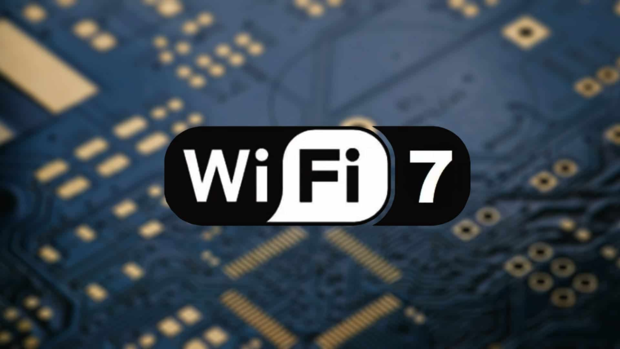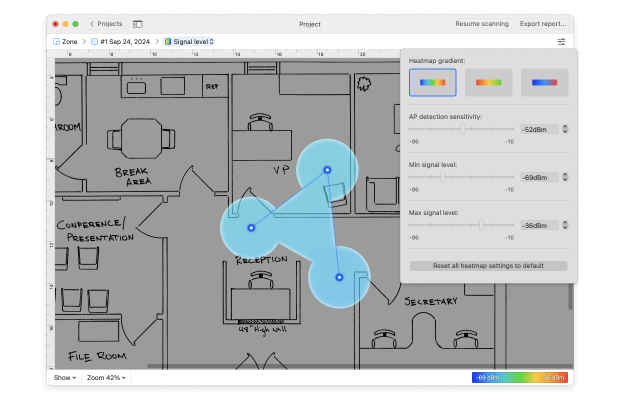Wi-Fi Site Surveys, Analysis, Troubleshooting runs on a MacBook (macOS 11+) or any laptop (Windows 7/8/10/11) with a standard 802.11be/ax/ac/n/g/a/b wireless network adapter. Read more about the 802.11be support here.
Explaining WiFi standards
Since the introduction of WiFi technology, multiple confusingly named WiFi standards have been released, and not many users understand what they mean. This and other articles published on the NetSpot blog are here to help you understand the differences between them.
WiFi relies on a simple idea: instead of sending signals through a wire, send through the air. It’s evolution follows the same route as the telephone: first telephone calls were transmitted over wires, then the air. Networks went the same way — first with thick cables, then smaller faster ones, and now transmitted through the air all the way to satellites in space.
Wi-Fi Standards In A Nutshell
WiFi is a marketing term coined by the brand-consulting firm Interbrand to promote a family of wireless network protocols used for local area networking and internet access. It doesn’t mean “Wireless Fidelity” as is often wrongly stated.
There are all sorts of acronyms for the different flavors of WiFi networks, but they all basically mean a few things:
- How far can the wireless signal reach
- How much data can the signal send
- Is it backwards compatible with other standards
Think of it like cars:
- A race car can’t go far on a tank of gas or carry a lot, but it can go very fast
- An 18 wheel truck can’t go very fast, but it can carry a lot of things in it and go a long way
- A station wagon isn’t very fast and can’t carry as much as an 18 wheeler, but it can still go pretty far
Of course, WiFi signals aren’t cars, but the analogy works pretty well. Just think how far can a network go, and how fast can it transmit data and the standards will make more sense.
IEEE 802.11 And The Standards Body
Who sets the standards for WiFi? That’s left up to the IEEE (Institute of Electrical and Electronics Engineers). These are the people who sit around and decide things like how many bits are in a byte and the standards for encryption. They’re not going to come to a company’s house and take their lunch money if they don’t comply, but companies participate and go along with that the IEEE standards decides so their things work well together.
From this group, we get the various flavors of WiFi. They’re all called the IEEE 802.11 standard with the letter after the 802.11 numbers. The usual rule is the higher the letter, the faster the speed of the network. Almost all of these function over a range of about 30 meters (150 feet).
Each network can be broken down by a few different settings:
- Speed: How much data the network can transmit between your device and the router, most commonly calculated in Mbps (1 million bits per second) or Gbps (1 billion bits per second) for newer standards. Note that this is the WiFi connection speed, not your internet speed, which will always be lower than your WiFi's maximum capability.
- Frequency: The radio frequency on which the network is broadcast, such as 2.4 GHz, 5 GHz, or 6 GHz. Lower frequencies like 2.4 GHz provide better wall penetration and longer range but offer slower speeds and more interference. Higher frequencies like 5 GHz and 6 GHz deliver faster speeds and less congestion but have shorter ranges and struggle more with obstacles like walls and floors.
Here’s a WiFi standards chart of each 802.11 standards type based on its designation:
| Name | Speed | Frequency |
|---|---|---|
| 802.11a | 6 to 54 Mbps | 5 GHz |
| Notes | Rather confusingly, the 802.11a standard doesn’t predate the 802.11b standard. Instead, it was supposed to support wireless communication in the 5 GHz band. Not compatible with b or g networks. This is one of the oldest standards, but still in use by many devices today. | |
| 802.11b | 1 to 11 Mbps | 2.4 GHz |
| Notes | Adopted in 1999, 802.11b became the first mainstream WiFi standard, delivering a maximum real-world throughput of around 6 Mbps. Compatible with g networks. Really, g was made to be backwards compatible with b to support more devices. | |
| 802.11d | N/A | N/A |
| Notes | 802.11d is an amendment to WiFi standards for operation in additional regulatory domains. D isn’t really a network type of its own. It includes additional information like access point information and other information specified by different country’s regulations. Usually, this is combined with other networks like 802.11ad. | |
| 802.11g | 6 to 54 Mbps | 2.4 GHz |
| Notes | The 802.11g standard offers a maximum throughput of 54 Mbps, and full backward compatibility with 802.11b. The most popular network type. Its combination of speed and backwards compatibility makes it a good match for today’s networks. | |
| 802.11n | 72 to 600 Mbps | 2.4 and 5 GHz |
| Notes | Retroactively labeled as WiFi 4, this is the first WiFi standard that can be used in the 2.4 GHz or 5 GHz frequency bands. 100 Mbps is common, though speeds of up to 600 Mbps is possible under perfect conditions. It does this by using multiple frequencies at once and joining that speed together. | |
| 802.11ac | 433 to 6933 Mbps | 5 GHz |
| Notes | This standard provides multi-station throughput of at least 1.1 Gbps and single-link throughput of at least 0.5 Gbps on the 5 GHz band. | |
| 802.11ax | 600 to 9608 Mbps | 2.4, 5 and 6 GHz |
| Notes | The one of the latest publicly available WiFi standard is 300 percent more efficient overall than 802.11ac. | |
| 802.11be | 1376 Mbps to 46 Gbps | 2.4, 5 and 6 GHz |
| Notes | WiFi 7 is the newest WiFi standard, whose certification program was introduced in 2024. It delivers unprecedented speed through new WiFi technologies like 320 MHz channels, 4K-QAM, and Multi-Link Operation (MLO). | |
| 802.11mc | N/A | N/A |
| Notes | 802.11mc is the third maintenance/revision group for the IEEE 802.11 WLAN standards, and it incorporates features like WiFi RTT. | |
The second rule is a combination of numbers means the router support different network types. So when networks like 802.11 ac, 801.11 ad, 802.11 abg are listed, it means that each of those types is supported by that router.
Latest Wi-Fi Standards
To make WiFi standards easier to understand, the WiFi Alliance introduced simplified naming conventions. Instead of technical designations like "802.11b" or "802.11ax," we now have consumer-friendly names like "WiFi 6" and "WiFi 7." Here's how the naming system works:
| WiFi Standard | Networks |
|---|---|
| WiFi 1 | 802.11b |
| WiFi 2 | 802.11a |
| WiFi 3 | 802.11g |
| WiFi 4 | 802.11n |
| WiFi 5 | 802.11ac |
| WiFi 6 | 802.11ax |
| WiFi 7 | 802.11be |
This naming system is similar to how mobile phone companies use terms like 3G, 4G, and 5G to distinguish between different generations of cellular technology. Just as 5G represents faster mobile data than 4G, WiFi 7 delivers significantly better performance than WiFi 6.
What Is Wi-Fi 6?
As you can see, the latest WiFi standard is WiFi 6 (or 802.11 ax). The standard support the already widespread 2.4 and 5 GHz bands, and it also uses the 6 GHz band for increased throughput-per-area in high-density scenarios.
Additional performance gains are unlocked by features such as orthogonal frequency-division multiple access (OFDMA), higher-order modulation, and Multi-User Multiple-Input Multiple-Output (MU-MIMO), each of which deserves its own in-depth article.

The maximum linkrate of WiFi 6 is between 600 and 9608 Mbps, depending on how many channels are utilized. Considering that the average internet speed in the US is just 42 Mbps, it’s safe to say that WiFi 6 is plenty fast for most people.
As the latest WiFi standard, WiFi 6 also supports the WPA3 security protocol. This protocol replaces the pre-shared key (PSK) exchange with Simultaneous Authentication of Equals (SAE) exchange to address security issues posed by weak passwords.
This means that it will be easier to have devices join a public WiFi network while still keeping private information private. As more people connect in coffee shops, libraries, churches, and schools, keeping bank connections and other secure communications from prying eyes will be essential.
There are more information leaks and data being sold online, so these enhanced encryption techniques will make it safer to be out on public WiFi systems.
WiFi 6 was adopted in 2019, and there are already many routers on the market that support the standard. Best of all, the same routers are compatible with other current WiFi standards, so they work even with devices that don’t take advantage of WiFi 6.
Wi-Fi 6 vs Wi-Fi 6E
Many newly released routers are marketed as WiFi 6E-compatible, so what does it mean? Well, WiFi 6E is an extension to the WiFi 6 standard that adds support for the 6 GHz band.
The 6 GHz band actually extends from 5.925 GHz to 7.125 GHz, so it has a very wide frequency range of 1,200 MHz, much more than the 2.4 and 5 GHz bands.
Because the 6 GHz band is so wide, it can offer a lot of bandwidth to support our current and future connectivity needs. Its width and novelty make the 6 GHz band fairly resistant to signal interference caused by other WiFi devices, so it’s great for use in dense urban environments.
Just keep in mind that it’s not enough to own a WiFi 6E-compatible router to use the 6 GHz band — your devices (smartphones, laptops, and so on) also need to be 6E-compatible.
Devices that are not 6E-compatible work without any issues with WiFi 6E routers, but they can’t take full advantage of all the features and bands supported by them.
What is WiFi 7?
WiFi-7 (802.11be) is the newest WiFi standard. Its development started in 2021, and the official certification program kicked off in 2024. As the latest WiFi standard, it pushes wireless technology forward by delivering speeds that can reach up to 46 Gbps under ideal conditions. That’s nearly five times faster than WiFi 6 and comparable to high-speed wired connections.

The WiFi 7 speed improvements can be largely attributed to support for new WiFi technologies, such as 320 MHz channel bandwidth (double that of WiFi 6), 4K-QAM (4096 Quadrature Amplitude Modulation) for more efficient data encoding, and Multi-Link Operation (MLO) for the simultaneous connection of individual devices across multiple bands.
But WiFi 7 speed isn’t the only factor that makes the newest WiFi standard better than its predecessors. WiFi 7 also improves reliability through its Multi-Link Operation, which maintains stable connections even if one band experiences interference. On top of that, security is strengthened with mandatory WPA3 support and enhanced encryption protocols to provide better protection against cyber threats while maintaining the convenience of easy device connections.
Note: NetSpot for Windows already supports WiFi 7, so users can install it to analyze and optimize even the latest networks.
When Will WiFi 8 Come Out?
WiFi 8 (802.11bn) hasn't been released yet, but development is already in progress. The WiFi 8 release date is expected to be around 2028, but, of course, nobody can guarantee that it won’t get delayed.
What is WiFi 8 going to offer? Rather than focusing significantly on performance improvements, the 802.11bn standard emphasizes reliability, efficiency, and consistency to improve real-world performance in crowded environments like airports, stadiums, and apartment buildings where many networks overlap.
Improvements expected in WiFi 8 include:
- Optimized coordination between access points to reduce interference.
- Improved power efficiency for better battery life on mobile devices.
- Adaptive power management that adjusts based on network conditions.
- Better performance consistency across all connected devices.
So while the answer to "Is WiFi 8 out yet?" is no, the networking industry is already working tirelessly to create a future with more stable wireless connectivity.
New WiFi Standards: Preparing for a WiFi Future
With the new standards coming, what’s the best way to prepare? Things aren’t going to stand still and wait. Already, older devices are finding it harder and harder to connect to a modern WiFi world, like older tablets and portable gaming systems.
To keep compatibility, make sure that routers purchases can support legacy devices and be upgraded in the future. If there’s already a network in place, it’s a good idea to understand how the network works.

WiFi analyzers like NetSpot help visualize how routers work by scanning the WiFi network to gather data on signal strength, channel usage, and network security. These tools provide a detailed map of a network's coverage area, illustrating how signals from routers propagate through a space and how they might overlap or interfere with signals from other nearby routers.
By analyzing the spectrum of WiFi channels, NetSpot can identify channels that are congested with traffic from multiple networks, suggesting alternative, less crowded channels to improve network performance. Additionally, it assesses the security settings of the network, highlighting potential vulnerabilities.
Conclusion
WiFi 7 (802.11be) is now established as the latest WiFi standard, and WiFi 8 is already in development, so it’s safe to say that wireless technology is moving forward at a brisk pace. To continue taking advantage of these new technologies, it helps to be equipped with an equally modern WiFi analyzer like NetSpot. With it, you can determine the best place to place the routers (and repeaters in a mesh network), optimize channel settings, and configure security based on real data rather than guesswork.
WiFi Standards — FAQs
The best WiFi standard currently available is WiFi 7 (IEEE 802.11be). This newest WiFi standard offers speeds up to 46 Gbps, supports 320 MHz channels, and includes advanced features like Multi-Link Operation for superior reliability. The only problem is that many consumer devices still don’t accept it.
The IEEE standards for WiFi are sets of local area network (LAN) technical standards for the implementation of wireless local area network (WLAN) computer communication.
No, WiFi 6 is no longer the newest standard. WiFi 7 (802.11be) is now the latest WiFi standard. However, WiFi 6 remains the most widely adopted current standard, as most devices and routers still use it, and it provides excellent performance for typical home and business needs.
WiFi RTT, a technology that makes it possible to measure a distance of a WiFi-enabled device, by all devices that are compatible with the IEEE 802.11mc standard.
The newest WiFi standard is WiFi 7 (IEEE 802.11be). Its development started in 2021, and the official Wi-Fi CERTIFIED 7 certification program has been going on since 2024.
WiFi 7 (IEEE 802.11be) is the fastest WiFi standard currently available, offering theoretical speeds up to 46 Gbps. This makes it nearly five times faster than WiFi 6's maximum of 9.6 Gbps.
The main differences include speed (WiFi 7 reaches 46 Gbps vs WiFi 6's 9.6 Gbps), channel width (320 MHz vs 160 MHz), and new features like Multi-Link Operation in WiFi 7 that allows simultaneous connections across multiple bands. WiFi 7 also uses 4K-QAM for more efficient data encoding compared to WiFi 6's 1024-QAM.
For most home users, WiFi 7 might be overkill since typical internet speeds are far below what even WiFi 6 can handle. However, WiFi 7 is definitely worthwhile for future-proofing, professional content creators working with large files, gamers wanting minimal latency, or businesses with many simultaneous users.
No, WiFi 8 (802.11bn) has not been released yet. The WiFi 8 release date is expected around 2028. When it becomes available, it should make the wireless networks we all use every day much more reliable.
